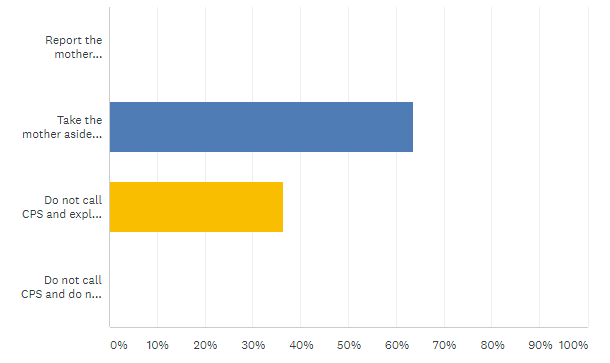In July, we examined the choice of a physician who is confronted with possible child abuse. Let’s take a second look:
You are a general practitioner and a mother comes into your office with her child who is complaining of flu-like symptoms. Upon entering the room, you ask the boy to remove his shirt, and you notice a pattern of very distinct bruises on the boy’s torso. You ask the mother where the bruises came from, and she tells you that they are from a procedure she performed on him known as “cao gio,” which is also known as “coining.” The procedure involves rubbing warm oils or gels on a person’s skin with a coin or other flat metal object. The mother explains that cao gio is used to raise out bad blood, and improve circulation and healing. When you touch the boy’s back with your stethoscope, he winces in pain from the bruises. You debate whether or not you should call Child Protective Services and report the mother. What do you do?
- Report the mother immediately. She has injured the child and it is your duty as a physician to report any suspected child abuse to CPS.
- Take the mother aside and explain to her that her actions are injuring her child and that you have no other option but to call CPS. As a physician, you must follow the law and it is best to explain this to the mother so she understands.
- Do not call CPS and explain to the mother that her son has been hurt by her efforts to help him. Show her an appropriate pressure to use when she is applying the gels. It is not your place to contradict her practice, but you must help the child.
- Do not call CPS and do not talk to the mother about the bruises. It is her child and she may use her own natural healing methods as she wishes.

A majority of our responders decided it was best to call CPS but also to explain to the mother why you are doing so. This response is aligned with the principle of beneficence. Almost 40% of responders decided they should discuss the issue with the mother but not report to CPS. This answer is aligned with the principle of autonomy, as it is the mother’s choice to “heal” her child as she wishes.
Here is our question for September:
A 67-year-old man presents to his physician complaining of discomfort in his lower abdomen and difficulty with urination. The man is 5 feet 11 inches tall and weighs 220 pounds. Although he used to smoke cigarettes, he was able to quit when he retired at age 65. Physical examination reveals an enlarged prostate. Suspecting the possibility of cancer, the physician orders a PSA test and tells the patient he will be contacted when the results are available. The patient is visibly upset at hearing the word “cancer” and, in spite of the physician’s reassurances of the low probability of malignancy, is physically shaking when he leaves the office. Several days later, the results of the test are received. The patient has a PSA of 3.5, elevated but below the commonly used screening test cutoff. At this point the physician’s best course of action would be to do which of the following?
Tell us what you think!
Bridget Ralston is a member of The University of Arizona College of Medicine – Phoenix Class of 2020. She graduated from Santa Clara University in 2015 with a Bachelor of Science in Chemistry and a French minor. She de-stresses by whipping up delicious treats (and subsequently devouring them), playing soccer, and cuddling with her cat, Tuxedo. She has a particular interest in healthcare for underserved communities.


